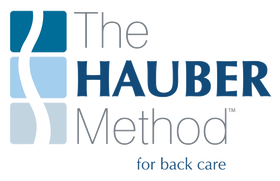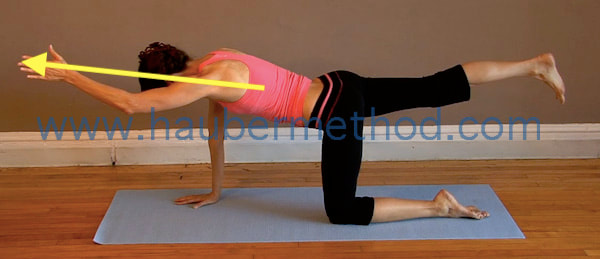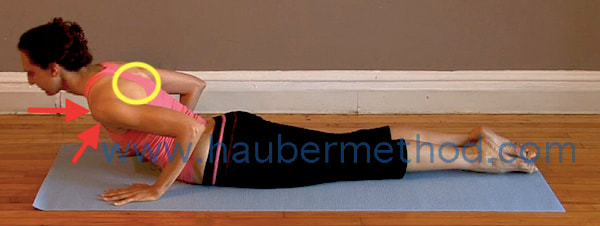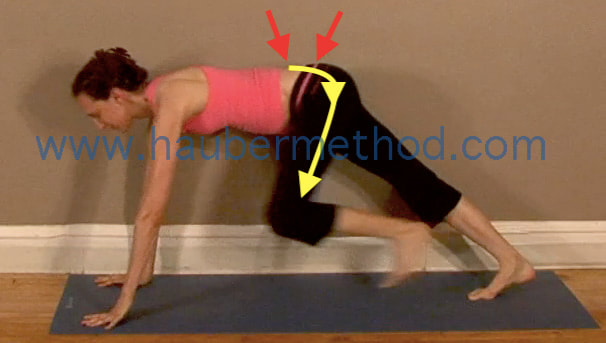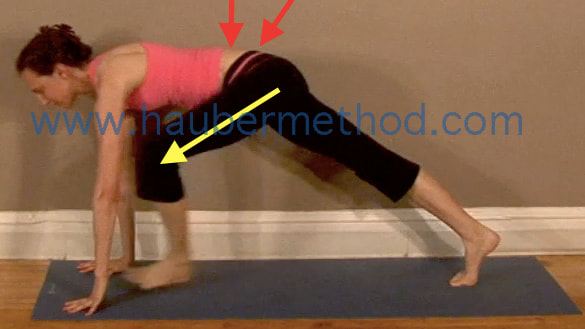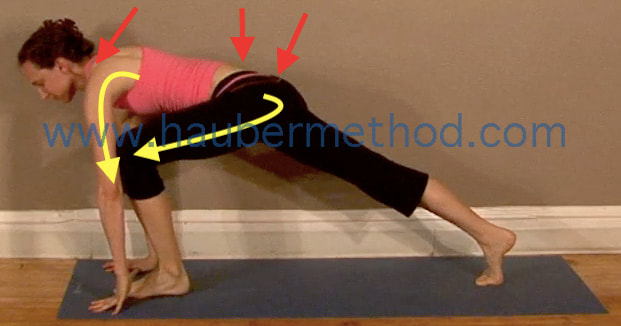Sun Salutations, Back Pain, and Shoulder Injury
Due to the fact that many physicians prescribe yoga practice to their back-pain patients, more and more people with back pain are taking yoga classes. The problems with this trend are manifold, as I talk about here and here.
But what if you want to practice yoga while you’re engaging in the Hauber Method™ or after you have completed all 3 series in the Hauber Method™ program? Can you?
Yes, you can.
I even incorporate some common yoga poses into the program. However, there are some specific poses that every person experiencing back pain should avoid during a yoga practice.
The main issue is forward folding, as I describe in this 2012 blog post at Sarahauber.com. But even worse than a simple Forward Fold is the ubiquitous “Sun Salutation,” Suryanamaskar.
I want to take this opportunity to break down why all Sun Salutations (and, thus, any Westernized Vinyasa/Flow yoga class) should be avoided by anyone with back pain or shoulder pain.
But what if you want to practice yoga while you’re engaging in the Hauber Method™ or after you have completed all 3 series in the Hauber Method™ program? Can you?
Yes, you can.
I even incorporate some common yoga poses into the program. However, there are some specific poses that every person experiencing back pain should avoid during a yoga practice.
The main issue is forward folding, as I describe in this 2012 blog post at Sarahauber.com. But even worse than a simple Forward Fold is the ubiquitous “Sun Salutation,” Suryanamaskar.
I want to take this opportunity to break down why all Sun Salutations (and, thus, any Westernized Vinyasa/Flow yoga class) should be avoided by anyone with back pain or shoulder pain.
Following are the steps of a Sun Salutation. Below the list, I describe how several of these poses, and transitions between poses, put your back and shoulder in danger if your joints are not totally flexible and functional, and your deep core is not stable and strong, already.
Poses in a Sun Salutation
Mountain Pose with hands in prayer
Mountain Pose with arms overhead
Forward Bend
Half Forward Bend
Forward Bend
Plank
Staff Pose (Chaturanga)
Upward Facing Dog
Downward Dog
Lunge to Forward Bend
Mountain Pose
Poses in a Sun Salutation
Mountain Pose with hands in prayer
Mountain Pose with arms overhead
Forward Bend
Half Forward Bend
Forward Bend
Plank
Staff Pose (Chaturanga)
Upward Facing Dog
Downward Dog
Lunge to Forward Bend
Mountain Pose
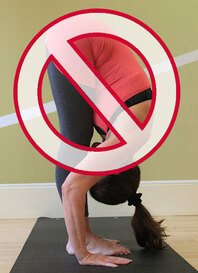
Problem 1 (purple poses on the list): The first area of risk for people with untrained deep core muscles, a pelvis that is chronically pulled out of neutral position due to tight hip flexors and tight hamstrings--all of which typically accompany or cause lower back pain--is the transition from Mountain Pose with arms overhead to the first Forward Bend.
Why is this problematic?
If you have those muscular imbalances I mentioned, your tight hamstrings and hip flexors will pull on your pelvis, leaving the lumbar vertebrae unstable and putting your entire lumbo-pelvic-hip complex in danger of soft-tissue injury. Read this post on Sarahauber.com explaining exactly why Forward Folds are bad news.
Sun Salutations, and thus, the Forward Folds featured in them, are done at the beginning of a typical Westernized yoga class. You are not warmed up, your tight hamstrings and hip flexors are not pliable, your deep core has not been stimulated or trained because you’re sitting like this all day leading up to class, and the second you rush from Mountain Pose to Forward Fold, you will feel pulling in your lower back or hips.
Why is this problematic?
If you have those muscular imbalances I mentioned, your tight hamstrings and hip flexors will pull on your pelvis, leaving the lumbar vertebrae unstable and putting your entire lumbo-pelvic-hip complex in danger of soft-tissue injury. Read this post on Sarahauber.com explaining exactly why Forward Folds are bad news.
Sun Salutations, and thus, the Forward Folds featured in them, are done at the beginning of a typical Westernized yoga class. You are not warmed up, your tight hamstrings and hip flexors are not pliable, your deep core has not been stimulated or trained because you’re sitting like this all day leading up to class, and the second you rush from Mountain Pose to Forward Fold, you will feel pulling in your lower back or hips.
Problem 2 (light green poses in the list): When you jump or step back into Plank Pose, you relieve the tension in your hips and lower back. That seems good, but the tension is quickly shifted instead to your shoulder joint as you transition into Chaturanga, and that’s an enormous, dangerous problem.
The shoulder joint is the most mobile joint in the entire body. It’s highly complex, with many muscles crossing through it, and with very little space between bones.
Most people are very tight in the chest (pectoralis major) and internal rotators of the shoulder (teres major, latissimus dorsi) because we sit all day long, we don’t stretch those muscles, and we don't strengthen our external rotators and shoulder-blade retractors (which you learn how to do in the Hauber Method™).
When you leap or step back into Plank from the Forward Fold, unless your deep core is super strong and consistently well trained, all of your body weight is being pushed quickly and with force into your internally rotated shoulder joints. And when you then quickly dip down to Chaturanga, it’s a recipe for rotator cuff tears and intense shoulder pain.
After a 3-week intensive yoga training in which we did maybe 400 Sun Salutations, my lats and pecs were so tight, my left shoulder was chronically internally rotated. You can see it below in two photos: (1) the very end of my transition through Chaturanga, and (2) this photo of me demonstrating how tight my shoulder capsule is by trying to do one of the core stabilizers you will practice as you get more conditioned in the Hauber Method™: My left arm should be straight, but the tension in my lats, triceps, and internal shoulder rotators is too strong to allow proper shoulder extension.
The shoulder joint is the most mobile joint in the entire body. It’s highly complex, with many muscles crossing through it, and with very little space between bones.
Most people are very tight in the chest (pectoralis major) and internal rotators of the shoulder (teres major, latissimus dorsi) because we sit all day long, we don’t stretch those muscles, and we don't strengthen our external rotators and shoulder-blade retractors (which you learn how to do in the Hauber Method™).
When you leap or step back into Plank from the Forward Fold, unless your deep core is super strong and consistently well trained, all of your body weight is being pushed quickly and with force into your internally rotated shoulder joints. And when you then quickly dip down to Chaturanga, it’s a recipe for rotator cuff tears and intense shoulder pain.
After a 3-week intensive yoga training in which we did maybe 400 Sun Salutations, my lats and pecs were so tight, my left shoulder was chronically internally rotated. You can see it below in two photos: (1) the very end of my transition through Chaturanga, and (2) this photo of me demonstrating how tight my shoulder capsule is by trying to do one of the core stabilizers you will practice as you get more conditioned in the Hauber Method™: My left arm should be straight, but the tension in my lats, triceps, and internal shoulder rotators is too strong to allow proper shoulder extension.
Pushing up from Plank/Chaturanga into Upward Facing Dog only makes things worse. See how internally rotated my shoulder is (Photo 3, below)? The yellow circle shows where I need strength (rhomboids, middle trapezius) to counteract the intense tension and tightness of my chest, lats, and internal rotators.
This is not just a problem with my anatomy: This is an extremely common problem for most people in our society due to repetitive faulty movements (such as too many Sun Salutations, too many push-ups, too many bench presses, i.e., training the prime movers rather than stabilizers and synergist muscles) and chronic internal rotation of the shoulder while sitting.
This is not just a problem with my anatomy: This is an extremely common problem for most people in our society due to repetitive faulty movements (such as too many Sun Salutations, too many push-ups, too many bench presses, i.e., training the prime movers rather than stabilizers and synergist muscles) and chronic internal rotation of the shoulder while sitting.
In fact, my experience at this yoga intensive is what led me to begin widespread teaching of the Hauber Method™ program in the first place! So many students, myself included, were in pain, wrecking our bodies with constant repetitions of the same yoga poses, 8 hours a day for 3 weeks, that I knew something was wrong.
I had no back pain or shoulder dysfunction the entire 11 years prior to this when the foundation of my physical activity was my functional strength and core training routine and I took a yoga class maybe 2 times per month.
That functional strength and core training routine is what became the Hauber Method™. And it quite literally will help any body obtain the proper postural control and deep core stabilization to be able to do Sun Salutations without pain or injury.
Only targeted stretches and the proper strength exercises for your middle back can correct the problems shown above and allow any of us to do a safe, rapid transition from Forward Fold to Plank to Chaturanga to Upward Facing Dog. Those important exercises are simply not part of flowing yoga classes. And they were certainly not part of the 3-week yoga intensive that I endured before these photos were taken.
If you want to see correct position of the shoulder joint during this difficult transition, see this well-made video on Yoga Journal [it will open in a new window or tab]. The model has excellent shoulder and upper-back mechanics, including strong middle-back muscles, and a well-stretched chest, neck, and front shoulder.
It's extremely rare that anyone with back pain who goes to a typical flowing yoga class will achieve this correct alignment (hence, why injury is so common).
My goal with the Hauber Method™ (especially Series C) is to get your chest, back, neck, and shoulder muscles to the point where you can achieve this alignment without any pain at all.
On a side note: The narrator in that video incorrectly states that Upward Dog stretches the back. It does not. In fact, it puts the back into extreme extension and, thus, compression. Nothing about the Chaturanga-Upward Dog pairing is a stretch for the back.
Problem 3 (red poses in the list): Downward Facing Dog is a fabulous pose for stretching the hamstrings and calves when you have strong and capable deep core muscles. If you don’t, your shoulder joint will again bear the burden of carrying your entire body weight! And, as I described above, your body is likely not in any kind of condition to do that without risking pain or injury.
Plus, staying in Downward Dog for several breaths (long enough to stretch your hamstrings and calves) emphasizes isometric contraction and strengthening of the lats and pecs and triceps--all of which are implicated in shoulder internal rotation.
But that’s not all.
When you then make your final transition from Downward Dog back through Lunge to Forward Fold, you must bring your legs back between your hands, which requires either a rounded back or very, very flexible hamstrings. The move also puts your shoulder at risk once again, as shown in the series of photos below. See that nasty internal rotation at the end of the sequence?
I had no back pain or shoulder dysfunction the entire 11 years prior to this when the foundation of my physical activity was my functional strength and core training routine and I took a yoga class maybe 2 times per month.
That functional strength and core training routine is what became the Hauber Method™. And it quite literally will help any body obtain the proper postural control and deep core stabilization to be able to do Sun Salutations without pain or injury.
Only targeted stretches and the proper strength exercises for your middle back can correct the problems shown above and allow any of us to do a safe, rapid transition from Forward Fold to Plank to Chaturanga to Upward Facing Dog. Those important exercises are simply not part of flowing yoga classes. And they were certainly not part of the 3-week yoga intensive that I endured before these photos were taken.
If you want to see correct position of the shoulder joint during this difficult transition, see this well-made video on Yoga Journal [it will open in a new window or tab]. The model has excellent shoulder and upper-back mechanics, including strong middle-back muscles, and a well-stretched chest, neck, and front shoulder.
It's extremely rare that anyone with back pain who goes to a typical flowing yoga class will achieve this correct alignment (hence, why injury is so common).
My goal with the Hauber Method™ (especially Series C) is to get your chest, back, neck, and shoulder muscles to the point where you can achieve this alignment without any pain at all.
On a side note: The narrator in that video incorrectly states that Upward Dog stretches the back. It does not. In fact, it puts the back into extreme extension and, thus, compression. Nothing about the Chaturanga-Upward Dog pairing is a stretch for the back.
Problem 3 (red poses in the list): Downward Facing Dog is a fabulous pose for stretching the hamstrings and calves when you have strong and capable deep core muscles. If you don’t, your shoulder joint will again bear the burden of carrying your entire body weight! And, as I described above, your body is likely not in any kind of condition to do that without risking pain or injury.
Plus, staying in Downward Dog for several breaths (long enough to stretch your hamstrings and calves) emphasizes isometric contraction and strengthening of the lats and pecs and triceps--all of which are implicated in shoulder internal rotation.
But that’s not all.
When you then make your final transition from Downward Dog back through Lunge to Forward Fold, you must bring your legs back between your hands, which requires either a rounded back or very, very flexible hamstrings. The move also puts your shoulder at risk once again, as shown in the series of photos below. See that nasty internal rotation at the end of the sequence?
In summary, Sun Salutations are loaded with poses that emphasize the strength and dominance of shoulder internal rotators and Forward Folds that put your lower back at risk due to tight hamstrings and untrained deep core stabilizers.
If you have not been consistently practicing preventive care and targeted training for your core, back, and hips, it’s a minor miracle that you have not been injured or left with pain after a standard, Westernized Vinyasa yoga class.
If you have not been consistently practicing preventive care and targeted training for your core, back, and hips, it’s a minor miracle that you have not been injured or left with pain after a standard, Westernized Vinyasa yoga class.
My very best advice is to stop attending yoga classes (unless they are small classes featuring static poses and a focus on joint alignment and breathing, like the ones I have taught) until you have completed the full Hauber Method™ workshop series or at least 5 private online sessions with me.
Your knowledge will skyrocket, your entire body will thank you, and your chances of injury--even during a class full of Sun Salutations--will plummet.
Your knowledge will skyrocket, your entire body will thank you, and your chances of injury--even during a class full of Sun Salutations--will plummet.
"Sun Salutations, Back Pain, and Shoulder Injury," by Sara Hauber.
First published December 11, 2019.
First published December 11, 2019.
Want to get back to healthy, safe yoga practice as soon as possible? Start your Hauber Method™ journey today!
Click the button below to book an introductory online session, and get your FREE sample from Hauber's Heal Your Back Handbook today.
Click the button below to book an introductory online session, and get your FREE sample from Hauber's Heal Your Back Handbook today.
Keep reading about how you can get empowered to stop your back and shoulder pain:
